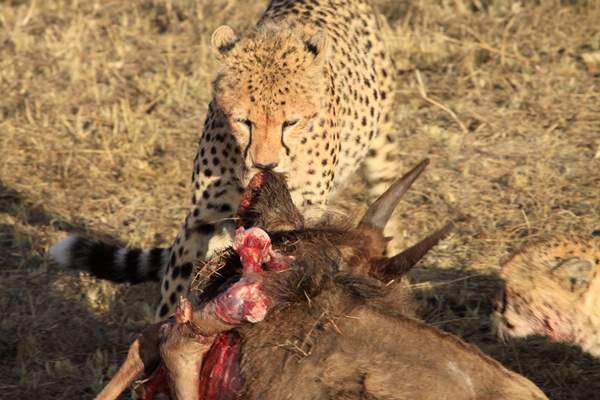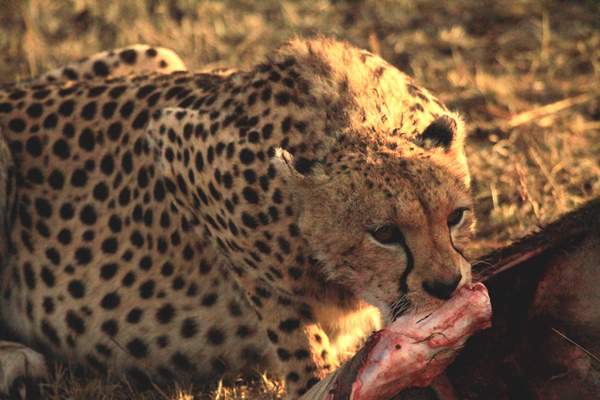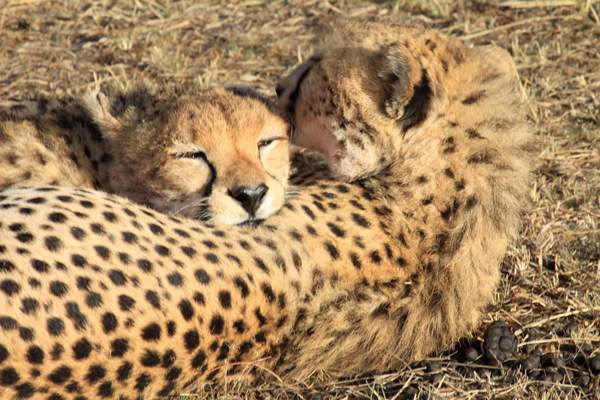Meeting Malaika; Cheetah In The BBC Series The Hunt

Malaika is a well known cheetah in the Masai Mara. She is relaxed around vehicles and shot to fame when she joined a shocked tourist, right inside his game viewing vehicle, a meeting that was written about in the Telegraph among others.
Lucinda, one of the sales team at Aardvark Safaris, was checking out camps in the Masai Mara recently when her guide found Malaika and her cubs and she was able to spend time with them and take the photographs below.
1. Where in Africa were you when you saw Malaika? Where were you staying?
I was in Kenya just last month staying at Sala’s Camp in the Masai Mara. This is a beautiful camp located on the Sand River. As we had a plane to catch onto our next location we decided to get up early to try to find her; we had seen her at a distance the day before so knew the area she was likely to be in. The excellent guide and tracker saw her as a speck in the grass from a distance; I still do not know how they saw her!

Malaika’s cub after the hunt. Image credit Lucinda Rome
2. Is the Masai Mara a good area for cheetah? Why?
The flat, open plains of the Masai Mara are perfect for cheetah. There’s abundant prey and plenty of termite mounds to give them vantage points to look for other predators and prey alike. We saw plenty of lion and leopard as well in our time here but spending the time with Malaika was a real highlight of the trip.
3. What was Malaika doing? What did she hunt?
We found Malaika just after dawn one morning; it was a magical experience being able to watch her from the vehicle only a few metres away. She was completely relaxed with us. She and her cubs were feeding on the wildebeest which she had brought down that morning shortly before we found her. After spending nearly an hour they had had their fill and moved off to find some shade for the day.

Malaika enjoying her spoils from the hunt, Image credit Lucinda Rome
4. Any top tips for photographing cheetah on safari?
As cheetah tend to live in open plains this is great for photographers as you are less likely to have a bush in the way. If you come across one on a termite mound or feeding always try and get the eye of the animal in your photo. As they interact with each other you can get action shots but in low light conditions these can be difficult to get in focus; a high ISO speed will help with this.
They can also represent a challenge to photograph; their black spots can make your camera over expose the image. If you are fortunate enough to see them hunt then their speed is a challenge in itself.
If like me you are lucky enough to see them static, remember to also put down your camera and soak up the experience by just watching them. Richard wrote about this in his recent blog on the 6 best cameras for safari, and it’s too easy to overlook the joy of being in the moment.

Malaika’s cubs grooming after the hunt. Image credit Lucinda Rome
5. Who are the other cheetahs in your photos?
They are Malaika’s cubs, who are quite big now and equally relaxed with vehicles. As we were able to spend so long with her with no other vehicles we able to see them completely at ease, cleaning each other, snoozing and playing. When there was a particularly delicious morsel they would bat each other gently to try and persuade the other to give it up with very little success!
What Next?
The reason the Aardvark Safaris’ team travels regularly to Africa is to ensure we know the camps intimately and can match you with the best safari guides. We’d be happy to discuss where best to stay to enjoy your own meeting with Malaika, or any of the other African species in “The Hunt” – please just give us a call, or pop us an email.
Explore the Safari Holiday Inspired By ‘The Hunt’
Read BBC’s The Hunt – The African wildlife and film location secrets revealed…
Leave a Reply